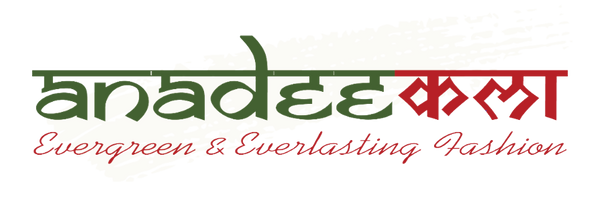
AJRAKH AT ANADEEKALA
Share
Being closest to our heart, our users may widely see Ajrakh in our designs. Ajrakh is a traditional block printing technique originated in the Kutch region of Gujarat, India. Be it geometrical design, floral motifs, paisley prints, peacocks or its intricate border patterns Ajrakh always succeeds in impressing people with its natural and intricate yet
elegant look. The Ajrakh printing process involves several steps, including washing and preparing the fabric, designing the pattern, carving the wooden blocks, dyeing the fabric, and printing the design on the fabric using the blocks. Printing Ajrakh fabric may take 8-12 days depending upon the design and the dyes used for the fabric. The traditional Ajrakh prints are mainly geometrical and symmetrical with intricate designs and borders. Here at AnadeeKALA, you will undoubtedly see these designs but in addition to that as we have promised to you, we have also made some modernised designs using the same age old techniques. Seeing our artisans create Ajrakh designs was definitely a treat for our eyes & so we have decided to take you through the process as much as possible through various articles.
The main processes are -
- De-sizing (Removing starch)
-
Harde
- Resist Print / Black Print / Alum Print
- Indigo dyeing (twice)
- Bhatti
- Final Washing
- Sun drying
1.De-sizing - While weaving the fabrics, starch is used in a weaving machine which has to be removed before starting the printing process. This process is call de-sizing. The de-sizing of the fabric can be done using 3 methods - using salt water (natural method), using camel-dunk (natural method) or using enzymes (chemicals).
Here at AnadeeKALA we do it using salt water.
The fabric is soaked overnight in a salt water and then dried entire day. This process is repeated until the fabric is completely starch-free, soft and ready for the next step.
2. Harde / Harda / Myrobalan - Once the de-sizing is done and the fabric is soft enough, it goes for the next step which is Harda process. Harda process (aka Myrobalan, Harada or Harde process) is a time-honoured technique that has been used for centuries in Indian textile industry to prepare natural fabrics such as cotton, silk, and wool for dyeing. The process begins by soaking the fabric in a solution made from Harda powder and water. The fabric is then washed and dried, after which it is ready for dyeing. The Harda treatment creates a natural mordant on the fabric, which helps to bind the dye to the fibres more effectively. Besides it has several other benefits, like enhancing the texture and colour of the fabric, making it more durable, and providing a natural antibacterial property. This process is eco-friendly and does not involve any harmful chemicals.
3. Resist Print / Black Print / Alum Print - Now since the fabric is ready for dying we move on to the next process where the printing is done. In Ajrakh print, multiple printing pastes are used like resist, black or Alum to create intricate patterns using wooden blocks. A resist paste is mixture of a glue (गोंद) and clay (मिट्टी) which prevents the dye from penetrating the fabric, creating a pattern in the original colour of the cloth. The cloth is then washed to remove any excess paste, and the fabric is dyed using natural dyes. The areas covered in the resist paste will retain their original colour, creating a beautiful contrast with the newly dyed areas. To hand block print design in black colour, the Black paste is formed using iron rust (लोहे का जंग) & jaggery (गुड़) mixture. Alum paste is formed using glue (गोंद) and alum (फिटकरी) to get red colour prints.
4. Indigo dyeing - This is the final dying process. Different natural ingredients can be used to create different colours like, indigo, pomegranate, Jaggery, Haldi, Henna, iron rust, alum, etc. But, the Indigo dyeing is primary and the most important part of Ajrakh textile tradition. The extract of natural indigo leaves is used to create indigo dyes. The dye is mixed with adequate amount of water. The printed fabric is dipped into this water and immediately kept for drying. Once it dries completely, they repeat the process for one more time. Note- the natural dyeing can be a challenging process, as these dyes are sensitive to changes in water, temperature and humidity.
5. Bhatti - Bhatti process is done to wash out the Resist (Clay) paste and clean the fabric. The fabrics are boiled in a water for an hour or two before the final wash. Alizarin is added in the water while boiling which acts as colour fixer.
6. Final Washing - The fabric is washed properly making sure there aren't any stains and then dried.
7. Sun Drying - At Anadeekala, the journey of every Ajrakh dyeing concludes under the open sky, where it absorbs not just the sun, but the soul of nature.
This step gently sets the colours, enhances the fabric’s natural texture, and brings out the true brilliance of earth-born dyes — without any artificial heat or chemicals.
Each piece of fabric, before reaching your hands, soaks in the warmth of sunlight — as if nature itself blesses it before it becomes a part of your wardrobe.
Tada.. Your Ajrakh fabric is ready.
So to summarize, Ajrakh (or Herbal) prints you see here are totally handmade and each design takes up-to 12 to 15 days to complete. At AnadeeKALA, with the original Ajrakh prints, we have also created some modern designs using these same traditional method and we are sure you are already loving them. Making and watching this beautiful heritage printing technique was a complete treat to our eyes and so we wanted to bring it to you through this article and videos. Thank you for all the love. Have a happy, guilt-free & sustainable shopping.
